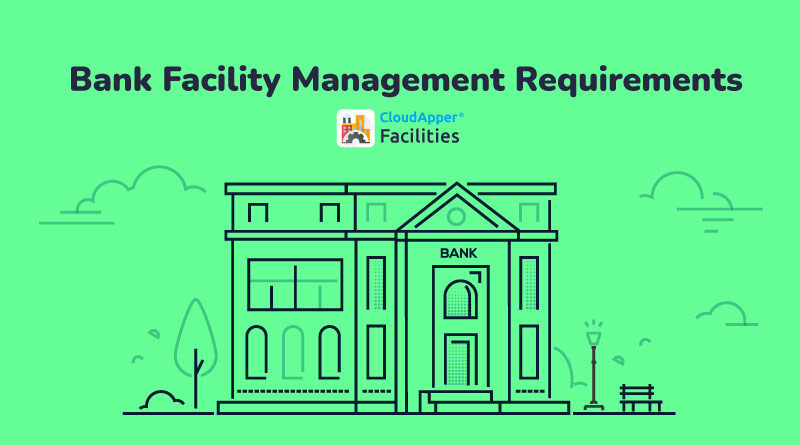Facilities Management Requirements and Challenges in The Banking Sector
The banking sector offers a plethora of financial services through local and corporate branches, brokers, ATM booths, corporate trading, and credit unions. While delivering these services, they need to cost-effectively implement facilities management (FM) in order to enhance customer experiences, all while ensuring transactions are conducted in a safe and secure environment.
According to the International Facility Management Association (IFMA), facility management is the practice of coordinating the physical workplace with the people and the work they carry out, through various forms of activities. This includes equipment maintenance, space planning, technological implementations, and portfolio forecasting. The growth of the facility management market has skyrocketed since the innovation of cloud-based models and has changed the organizational structure of workforce management. In the field of banking, these types of practices are certainly needed in order to tackle financial activities such as the management of treasuries, managing vendor documents, goods received, and payment-related information, as well as the management of customer-facing transactions.
According to a consumer study conducted in 2019, a majority of financial service customers prefer brick-and-mortar bank facilities over the online financial service solutions available. A customer’s preference for physical banking locations can be deemed an asset by the financial sector. Therefore, the maintenance of these facilities is vital. Facility managers must assist banks in achieving business goals wherever possible. This can include the reduction of operational costs while ensuring a high maintenance standard. This results in increased revenue and an improved customer experience- two vital aspects within banking.
The Importance of The Financial Institution Branch Design
The Financial Services sector carries a certain degree of importance, far outweighing other brand relationships throughout the course of an individual’s lifetime, as well as the level of intimacy surrounding personal wealth and daily banking approaches. Financial health is a critical factor for all consumers. Therefore, it is vital to understand how facilities managers play a key part in maintaining the customer experience. The 2019 Future Branches Consumer Study recorded that 19% of consumers view the physical design of the branch as a significant contributing factor to their appreciation of a physical banking experience. Thus, banks should priorities creating a consistent, repeatable, and dependable experience for all consumers at all their branches.
The role of the facilities management team is to ensure the effective delivery of support services for organizations, as well as add brand value to reinforce a promising image. The banking sector plays a crucial role in the development of facilities management. One is able to see this through the strategies put into place that enable customers to make the right decisions when banking. This can be achieved through implementing the right tools for customer engagement while maintaining an interactive level of technology.
How Bank Facility Management Technology Has Evolved
AI and customer service will become more integrated as they have experienced significant growth, according to IBM. In fact, by 2021, human agents won’t be present in 85% of customer interactions. While the financial sector has witnessed effective customer service experience thanks to technological advances, bank facility management technology and its potential specifically are quite intriguing. Help desk management software, for instance, enables banks to track issues and service requests by customers and respond accordingly.
With the aid of process automation and efficient technologies, bank officials and facility management staff members can add new customers, retain existing ones, and sell them financial products and services. A Bank Facility Management software can optimize daily business operations, improving productivity and efficiency. According to Deloitte’s 2019 Banking & Capital Markets Outlook, digital banking will receive over a whopping $15.2 billion in investment from retail banks in 2022, whereas $11.4 billion will be for developing branches. Irrespective of banks focusing on human interactions or technology, facilities management is required to aid with the customer experience cycle.
How Facilities Managers Maintain Banking Services
Source service providers and facility managers of financial institutions are usually based locally because local banks and credit unions, in particular, are often situated in residential communities. This helps facility managers in the banking industry to undertake responsibilities for maintenance and repair more efficiently. Regular monitoring and management of unmanned assets, such as ATMs, can prove to be challenging due to the specific technicalities that it possesses. Financial institutions must ensure that facilities managers conduct audits and risk compliance issues across physical footprints.
While there are many positives, the industry is not without its challenges, due to the evolving needs of consumers. One of the most pressing concerns is that many people are still unaware of the benefits of these services. As a result, all the banks within the industry will heavily rely on the latest technology and platforms. It is the responsibility of facility managers to automate facilities maintenance across any number of banking and financial institutions by delivering a solution that brings flexibility, transparency, and compliance for that matter. Additionally, a report states that facilities management accounts for 80% of the money spent in the lifecycle of a building from its inception, further reinforcing the significance of facilities management and maintenance in the banking industry.
How Bank Facility Management Software Can Help
Modern facility management software is highly customizable. This helps banking and financial organizations optimize their facilities in a cost-effective way, so they can better align with their business goals. Cloud-based facilities management software can help banks in ensuring improved operational efficiency without increasing the maintenance cost.
CloudApper Facilities is an innovative cloud-based facilities management software with several beneficial features and tools that allow facility managers to streamline various day-to-day business operations, enhancing the overall efficiency and productivity of employees. This also includes space optimization, help desk management, asset tracking, and controlling operational costs.










